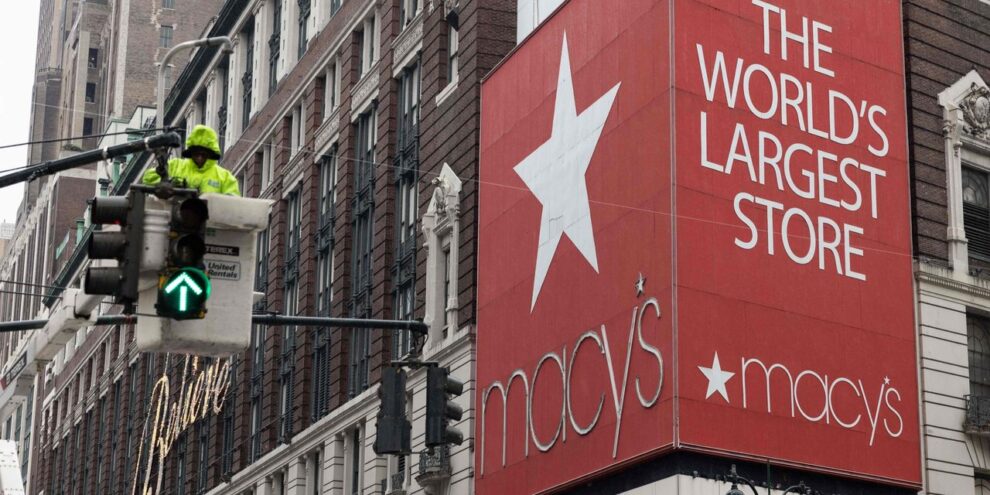
Macy’s executives on Tuesday outlined the ways that inflation is changing customer behavior across all income brackets, as higher prices for food and gas and rising interest rates weigh on sentiment.
Chief Executive Jeffrey Gennette told analysts on a call after the company’s second-quarter earnings report that customers from all walks of life slowed and shifted their spending in the quarter to end June.
“Overall consumer discretionary spending and sentiment weakened compared to the prior year,” he said, according to a FactSet transcript. “Constrained consumer spend also shifted from goods to services, with more consumers choosing to spend on vacations, events and dining out.”
The move led to sales gains of 8% for occasion-based categories such as business wear, sportswear, fragrances, shoes, dresses and luggage, he said. But pandemic-linked categories, such as active, casual, sportswear, sleepwear and soft home goods, saw sales fall 18% from the year-earlier period and 12% from the second quarter of 2019, before the start of the pandemic.
See now: Macy’s continues its move away from the mall with new small-store locations
Read: Here’s why Target was willing to pay so much to sell off excess inventory
The back half of the quarter was weaker than the first half, and a slowdown in sales that came after Father’s Day continued into July. Macy’s M, +3.76% was unable to escape the buildup of excess inventory that is hurting many retailers and leading to steep discounting to clear out stock.
“To better align inventory levels with consumer demand, we slowed receipts in market brands where we have more flexibility than our private brands,” said Gennette. “We effectively pulled the appropriate levers to manage inventory productivity while flowing fresh inventory to meet our customer needs.”
The company is expecting its inventory issues to be resolved by the holiday season and expects more than 55% of its offerings then to be new.
See: Macy’s will bring Toys ‘R’ Us to every one of its U.S. stores for the holidays
The company’s new digital marketplace is expected to launch in the coming weeks and will allow third-party merchants to sell their goods on the Macy’s and Bloomingdale’s websites across a range of categories, from pets to baby and toys.
Chief Financial Officer Adrian Mitchell said the company did see early signs of rising credit delinquencies in the quarter and slower payment rates as customers grappled with inflationary pressures. “We are taking a measured view on bad debt for the remainder of the year,” he said.
Don’t miss: Here’s what the big inventory problem for retailers looks like
See: Kohl’s plans for smaller stores as dozens of existing store leases approach expiration
Macy’s shares rose more than 6% as investors focused on consensus-beating second-quarter earnings and not lowered guidance.
The company posted net income of $275 million, or 99 cents a share, for the quarter, down from $345 million, or $1.08 a share, in the year-earlier period. Adjusted per-share earnings came to $1, ahead of the 86-cent FactSet consensus.
Sales edged down to $5.6 billion from $5.647 billion a year ago but were also ahead of the $5.49 billion FactSet consensus. Same-store sales fell 1.6%, compared with a FactSet consensus for a drop of 2%.
The company cut guidance to reflect “the risk it sees in the continued deterioration of consumer discretionary spending in some of its categories and the level of inventory within the industry, as well as risks associated with a more pronounced macro downturn.”
It’s now expecting full-year sales of $24.34 billion to $24.58 billion, compared with a May forecast of $24.46 billion to $24.7 billion. It expects adjusted EPS of $4 to $4.20, down from May guidance of $4.53 to $4.95.
The FactSet consensus is for full-year EPS of $4.23 and sales of $24.383 billion.
The company said its gross margin shrank by 170 basis points to 38.9% from the year-earlier period. Sales, general and administration costs as a percentage of revenue narrowed by 180 basis points to 35.4%.
“The margin compression was due to higher promotional activity and the company bringing back workers at its retail locations,” said CFRA analyst Zachary Warring.
“We are impressed with the company’s inventory management with inventory up just 7% [on a year-over-year basis] and down 8% compared to pre-pandemic levels. We continue to see value in shares even if sales and EPS are lower over the next few years as the company trades at well under [10 times] EPS.”
CFRA rates the stock a buy.
Macy’s shares are down 25% to date in 2022, while the the ProShares Decline of the Retail Store ETF EMTY, +0.21% has gained about 2% and the S&P 500 SPX, -0.22% has fallen 13%.




